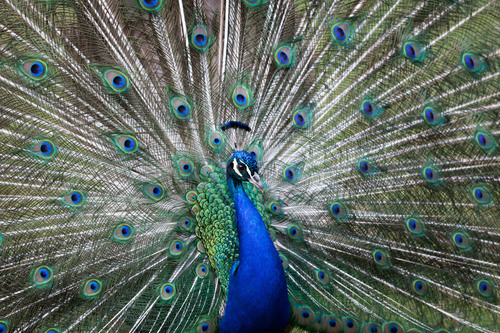
Indian Peafowl
The Indian Peafowl (Pavo cristatus), commonly known as the peacock, is a large and vibrantly colored bird native to South Asia. Renowned for the male's extravagant iridescent tail feathers, which are displayed in a spectacular fan during courtship, the peafowl holds a significant place in various cultures, often symbolizing beauty, royalty, and immortality. Ecologically, they play a role in seed dispersal and insect control, contributing to the biodiversity of their native habitats. They are well-adapted to a variety of environments, from forests to agricultural lands.
100-230 cm
Length
130-160 cm
Wingspan
Least Concern
Conservation Status
Distribution
Native to the Indian subcontinent, including India, Sri Lanka, and parts of Nepal, Bhutan, and Bangladesh. Introduced populations exist in many other parts of the world, including the United States, Australia, and South Africa.
Lifespan
10-25 years in the wild; up to 25 years or more in captivity.
Indian Peafowl's Habitat
Habitat Types
Deciduous forests, Scrublands, Agricultural areas, Near human settlements
Climate Zones
Tropical, Subtropical
Adaptations
Adaptable to a range of environments, thriving in both moist and dry deciduous forests. They are often found near water sources and prefer areas with dense undergrowth for cover.
Variations
While *Pavo cristatus* is generally considered monotypic (no recognized subspecies), some regional variations in plumage color and size have been anecdotally observed, but not formally classified.
Appearance
Breeding Plumage
Males exhibit striking iridescent blue and green plumage, with a prominent train of elongated upper tail coverts bearing ocelli (eyespots) during the breeding season. Females (peahens) have cryptic brown, grey, and cream plumage. Non-breeding males may have shorter trains.
Seasonal Feather Changes
Males molt and regrow their train annually. The train is fully developed during the breeding season.
Sex Based Plumage Differences
Significant sexual dimorphism. Males are brightly colored with the iconic train, while females are much duller in coloration.
Notable Features
Elongated train with ocelli (males), Crest of feathers on head (both sexes), Strong legs and feet for running and scratching
Diet and Feeding
Primary Foods
Seeds, Insects, Fruits, Small reptiles, Small mammals, Grains
Foraging Behavior
Forages on the ground, scratching at the leaf litter and soil with their feet to uncover food. Often feeds in small groups, particularly in the early morning and late afternoon.
Specializations
No highly specialized feeding adaptations, reflecting their generalist diet.
Seasonal Diet Variations
Diet may vary slightly with seasonal availability of food resources. For example, they may consume more insects during the monsoon season when insect populations are high.
Behavior
Social Structure
Generally found in small groups, consisting of a male and several females, or bachelor groups of males. Outside of the breeding season, they may form larger flocks.
Communication
Loud, piercing calls (especially by males during breeding season), Visual displays (train display by males), Low-frequency vocalizations (possibly infrasonic, used for long-distance communication)
Migration
Indian Peafowl are generally non-migratory, but they may make local movements in response to food availability or water sources.
Territorial or Group Behaviors
Males are territorial during the breeding season, defending a display area (lek) where they court females. Females may roam between different male territories.
Conservation
Threats
Habitat loss (due to agriculture and urbanization), Poaching (for feathers and meat, though illegal in many areas), Pesticide poisoning, Predation by feral dogs and other animals
Protection Programs
Protected under the Indian Wildlife Protection Act of 1972, CITES Appendix III (regulates international trade), Habitat conservation efforts in protected areas
Local National Laws
Fully protected in India. Hunting and trade are illegal.
Population Trend
Stable
Population Estimates
Global population is not precisely quantified, but considered to be large and not currently threatened.
Interesting Facts
The 'eyes' on a peacock's train are called ocelli.
These markings play a crucial role in attracting females during courtship.
Peafowl are capable of flight, despite their large size.
They often roost in trees at night to avoid predators.
The Indian Peafowl is the national bird of India.
It holds a significant place in Indian culture and mythology.
The collective noun for peafowl is an 'ostentation' or a 'muster'.
These terms reflect the showy nature of the birds.
Faqs about Indian Peafowl
What is the difference between a peacock and a peahen?
Peacock refers to the male, while peahen refers to the female. The term 'peafowl' encompasses both sexes.
Why do peacocks have such long tails?
The long train is used in courtship displays to attract females. Females are thought to choose males based on the size, color, and symmetry of their trains.
Are peacocks aggressive?
Males can be territorial during the breeding season, but they are generally not aggressive towards humans unless threatened.
Can peafowl be kept as pets?
While they can be kept in captivity, peafowl require large spaces and specific care. Local regulations should be checked before acquiring peafowl.
Copyright @ Nature Style Limited. All Rights Reserved.
 English
English